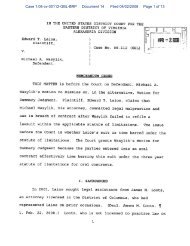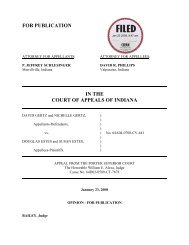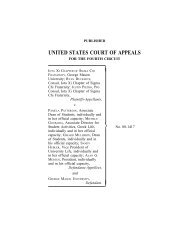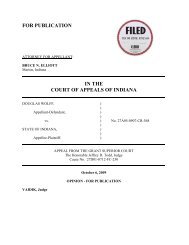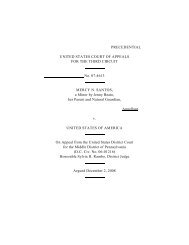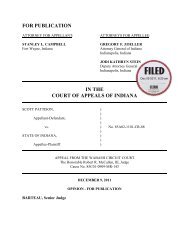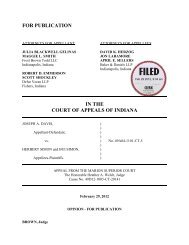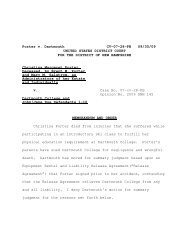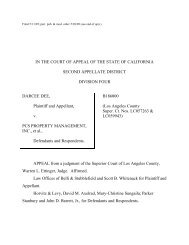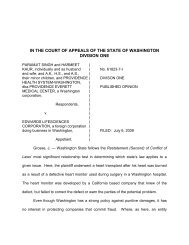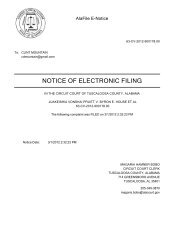Gambardella v. Apple Health Care, Inc. - Connecticut Judicial Branch
Gambardella v. Apple Health Care, Inc. - Connecticut Judicial Branch
Gambardella v. Apple Health Care, Inc. - Connecticut Judicial Branch
Create successful ePaper yourself
Turn your PDF publications into a flip-book with our unique Google optimized e-Paper software.
******************************************************<br />
The ‘‘officially released’’ date that appears near the<br />
beginning of each opinion is the date the opinion will<br />
be published in the <strong>Connecticut</strong> Law Journal or the<br />
date it was released as a slip opinion. The operative<br />
date for the beginning of all time periods for filing<br />
postopinion motions and petitions for certification is<br />
the ‘‘officially released’’ date appearing in the opinion.<br />
In no event will any such motions be accepted before<br />
the ‘‘officially released’’ date.<br />
All opinions are subject to modification and technical<br />
correction prior to official publication in the <strong>Connecticut</strong><br />
Reports and <strong>Connecticut</strong> Appellate Reports. In the<br />
event of discrepancies between the electronic version<br />
of an opinion and the print version appearing in the<br />
<strong>Connecticut</strong> Law Journal and subsequently in the <strong>Connecticut</strong><br />
Reports or <strong>Connecticut</strong> Appellate Reports, the<br />
latest print version is to be considered authoritative.<br />
The syllabus and procedural history accompanying<br />
the opinion as it appears on the Commission on Official<br />
Legal Publications Electronic Bulletin Board Service<br />
and in the <strong>Connecticut</strong> Law Journal and bound volumes<br />
of official reports are copyrighted by the Secretary of<br />
the State, State of <strong>Connecticut</strong>, and may not be reproduced<br />
and distributed without the express written permission<br />
of the Commission on Official Legal<br />
Publications, <strong>Judicial</strong> <strong>Branch</strong>, State of <strong>Connecticut</strong>.<br />
******************************************************
LAURIE GAMBARDELLA v. APPLE HEALTH<br />
CARE, INC., ET AL.<br />
(SC 17977)<br />
Rogers, C. J., and Norcott, Katz, Palmer and Sullivan, Js.<br />
Argued February 13—officially released May 19, 2009<br />
Brendon P. Levesque, with whom were Karen L.<br />
Dowd and, on the brief, Wesley W. Horton, Michael S.<br />
Taylor and Dana M. Hrelic, certified legal intern, for<br />
the appellants (defendants).<br />
Stephen E. Pliakas, with whom were Robert Nastri,<br />
Jr., and, on the brief, Jeffrey J. Tinley, for the appellee<br />
(plaintiff).
Opinion<br />
KATZ, J. The plaintiff, Laurie <strong>Gambardella</strong>, filed a<br />
defamation action against the defendants, <strong>Apple</strong> <strong>Health</strong><br />
<strong>Care</strong>, <strong>Inc</strong>. (<strong>Apple</strong>), Waterbury Extended <strong>Care</strong> Facility,<br />
<strong>Inc</strong>. (facility), and facility administrator John Sweeney,<br />
alleging that they had communicated false accusations<br />
of theft to others in connection with their termination<br />
of her employment. The case was tried to the court,<br />
Gallagher, J., which rendered judgment in favor of the<br />
plaintiff. The defendants appealed from the judgment<br />
of the trial court, 1 claiming that the court improperly<br />
had rejected their defense of the qualified privilege for<br />
intracorporate communications because it failed to<br />
apply an actual malice standard when determining that<br />
the defendants had lost the privilege and because there<br />
was insufficient evidence to support a finding of actual<br />
malice. We conclude that the trial court applied an<br />
actual malice standard and that its decision is supported<br />
by the record. Accordingly, we affirm the judgment of<br />
the trial court.<br />
The record discloses the following undisputed facts<br />
and procedural history relevant to this appeal. The<br />
plaintiff was employed by the facility, which is owned<br />
and operated by <strong>Apple</strong>, as an admissions counselor<br />
from September, 1998, until her discharge on May 25,<br />
2000. In the course of her employment, the plaintiff met<br />
with Eleanore O’Sullivan concerning the admission of<br />
O’Sullivan’s aunt, Fannie Lauro, to the facility. Upon<br />
Lauro’s admission to the facility on May 12, 2000, O’Sullivan<br />
brought a number of items of Lauro’s personal<br />
property, including clothing and furniture, to the facility<br />
for Lauro’s use. Days later, Lauro suffered a massive<br />
heart attack. She died at Waterbury Hospital on May<br />
15, 2000.<br />
O’Sullivan subsequently went to the facility to<br />
retrieve some articles of clothing for Lauro’s funeral,<br />
and she and the plaintiff discussed the disposition of<br />
Lauro’s personal property remaining at the facility.<br />
O’Sullivan told the plaintiff that she was not interested<br />
in the property and that the plaintiff should do whatever<br />
she wanted with the items. The plaintiff decided to keep<br />
two chairs for herself. On the evening of May 18, 2000,<br />
the plaintiff contacted Colleen Busk, the nursing supervisor<br />
on duty at the facility, to inform Busk that the<br />
plaintiff’s son and a friend would be coming to take the<br />
chairs from Lauro’s room. Busk asked if she could have<br />
the dresser from the room. The plaintiff agreed, and<br />
Busk removed the dresser. The plaintiff later informed<br />
Joseph Stolfi, the facility’s maintenance supervisor, that<br />
the remaining furniture was available for use elsewhere<br />
in the facility. Stolfi asked about the chairs and the<br />
dresser, and the plaintiff informed him that those items<br />
had been taken care of already. Thereafter, Stolfi contacted<br />
Sweeney to apprise him of the situation.
Sweeney decided to conduct an investigation into the<br />
disposition of the property. He spoke with the plaintiff,<br />
who explained that O’Sullivan had given her the furniture<br />
and that she had taken some of it to her home and<br />
had given some of it to Busk. Sweeney informed her<br />
that there was a corporate policy against accepting gifts<br />
from residents and their families. 2 The plaintiff was not<br />
aware of the policy, but after being informed of it,<br />
she subsequently returned the chairs to the facility.<br />
Sweeney directed Kathy Breidenbach, a social worker<br />
at the facility, to contact O’Sullivan to ascertain her<br />
wishes with respect to the property. O’Sullivan confirmed<br />
the plaintiff’s account to Breidenbach, and<br />
Breidenbach informed Sweeney, providing him with<br />
handwritten notes of the conversation. Sweeney then<br />
contacted O’Sullivan directly, who verified that she had<br />
given the furniture to the plaintiff to keep or give to<br />
others as she saw fit. O’Sullivan subsequently sent a<br />
letter to the plaintiff in which she stated that the property<br />
had been left for the plaintiff to keep for herself<br />
or distribute to others in her sole discretion. 3 Sweeney<br />
received a copy of this letter.<br />
Despite the results of this investigation, Sweeney<br />
decided that the plaintiff had stolen the furniture. He<br />
concluded that, because company policy barred<br />
employees from accepting gifts from residents or their<br />
families, the furniture belonged to the facility. Therefore,<br />
he determined that, when the plaintiff removed<br />
the furniture from the facility, she had committed theft.<br />
He forwarded the results of his investigation, except<br />
for the substance of his own conversation with O’Sullivan,<br />
to Jack Boynton, director of human resources for<br />
<strong>Apple</strong>, and recommended that the plaintiff’s employment<br />
be terminated for theft. After reviewing the information<br />
provided to him, Boynton approved the<br />
termination.<br />
Sweeney thereafter scheduled a meeting between<br />
himself and the plaintiff to inform her that her employment<br />
was being terminated. In accordance with <strong>Apple</strong>’s<br />
corporate policy requiring the presence of a witness<br />
at termination meetings, Sweeney asked Kate Sloan,<br />
director of admissions and marketing for <strong>Apple</strong>, to be<br />
present. At the meeting, Sweeney presented the plaintiff<br />
with a disciplinary action report indicating that her<br />
employment was being terminated and explained that<br />
she was being fired for theft because she had taken the<br />
chairs, which belonged to the facility, from Lauro’s<br />
room.<br />
Other individuals subsequently learned the reason<br />
for the plaintiff’s employment termination. Busk had<br />
heard some facility employees discussing the fact that<br />
the plaintiff had been fired for taking furniture. Other<br />
people, including the plaintiff’s daughter, also had heard<br />
that the plaintiff had been fired for ‘‘taking furniture<br />
from a dead lady . . . .’’
Thereafter, the plaintiff brought an action for defamation<br />
against the defendants. 4 In response, the defendants<br />
contended that any defamatory statement that<br />
may have been made was protected by a qualified privilege<br />
for intracorporate communications regarding an<br />
employee’s termination.<br />
Following a trial to the court, Judge Gallagher issued<br />
two decisions, the first of which found the defendants<br />
liable for defamation, and the second of which awarded<br />
general, special and punitive damages for a total of<br />
$224,481 in damages, plus costs, to the plaintiff. The<br />
court concluded that the plaintiff had established that<br />
O’Sullivan had given the furniture to her, and that the<br />
defendants had published false allegations of theft to<br />
third parties, which constituted defamation per se. The<br />
trial court rejected the defendants’ claim that such communications<br />
were protected by the qualified privilege<br />
for intracorporate communications because, as a result<br />
of Sweeney’s investigation, the defendants undoubtedly<br />
had known that the allegation of theft was false. It also<br />
found that the defendants’ insistence that the plaintiff<br />
had committed theft, despite Sweeney’s investigation,<br />
was further evidence of their bad faith. The trial court<br />
thereafter rendered judgment in favor of the plaintiff,<br />
and this appeal followed. See footnote 1 of this opinion.<br />
Additional facts will be set forth as necessary.<br />
On appeal, the defendants claim that the trial court<br />
improperly determined that the qualified privilege for<br />
intracorporate communications had been abused and<br />
therefore lost. Specifically, they contend that, although<br />
<strong>Connecticut</strong> courts have recognized that a qualified<br />
privilege may be defeated by a showing of either actual<br />
malice, i.e., publication of a statement with knowledge<br />
of the statement’s falsity or reckless disregard for its<br />
truth, or malice in fact, i.e., publication of a false statement<br />
with bad faith or improper motive, this case law<br />
overall has been inconsistent and this court specifically<br />
has left open the question of which standard should be<br />
applied to defeat the qualified privilege for intracorporate<br />
communications. They assert that the purpose<br />
underlying this privilege is of sufficient importance that<br />
this court should require the more stringent showing<br />
of actual malice, rather than malice in fact, to defeat<br />
the qualified privilege. The defendants further claim<br />
that there was insufficient evidence in the present case<br />
to show either actual malice or bad faith. 5<br />
In response, the plaintiff contends that the settled<br />
law in <strong>Connecticut</strong> permits a showing of either actual<br />
malice or malice in fact to defeat the qualified privilege<br />
for intracorporate communications in a defamation<br />
case brought by a person who is not a public figure.<br />
She also claims that the trial court properly found, and<br />
the evidence supports, that the false statements had<br />
been published both with actual malice and malice in<br />
fact. 6 We agree with the plaintiff.
We begin our analysis by setting forth the relevant<br />
legal principles and the proper standard for our review.<br />
‘‘A defamatory statement is defined as a communication<br />
that tends to harm the reputation of another as to lower<br />
him in the estimation of the community or to deter third<br />
persons from associating or dealing with him . . . . To<br />
establish a prima facie case of defamation, the plaintiff<br />
must demonstrate that: (1) the defendant published a<br />
defamatory statement; (2) the defamatory statement<br />
identified the plaintiff to a third person; (3) the defamatory<br />
statement was published to a third person; and (4)<br />
the plaintiff’s reputation suffered injury as a result of<br />
the statement.’’ (Citations omitted; internal quotation<br />
marks omitted.) Cweklinsky v. Mobil Chemical Co., 267<br />
Conn. 210, 217, 837 A.2d 759 (2004). If the plaintiff is<br />
a public figure, however, the plaintiff also must prove<br />
that the defamatory statement was made with actual<br />
malice, such that ‘‘the statement, when made, [was]<br />
made with actual knowledge that it was false or with<br />
reckless disregard of whether it was false.’’ (Internal<br />
quotation marks omitted.) Woodcock v. Journal Publishing<br />
Co., 230 Conn. 525, 535, 646 A.2d 92 (1994),<br />
cert. denied, 513 U.S. 1149, 115 S. Ct. 1098, 130 L. Ed.<br />
2d 1066 (1995), citing New York Times Co. v. Sullivan,<br />
376 U.S. 254, 279–80, 84 S. Ct. 710, 11 L. Ed. 2d 686<br />
(1964). Additionally, to recover punitive damages, a<br />
plaintiff must prove actual malice, regardless of<br />
whether the plaintiff is a public figure. See Triangle<br />
Sheet Metal Works, <strong>Inc</strong>. v. Silver, 154 Conn. 116, 127,<br />
222 A.2d 220 (1966); Proto v. Bridgeport Herald Corp.,<br />
136 Conn. 557, 571, 72 A.2d 820 (1950).<br />
A defendant may shield himself from liability for defamation<br />
by asserting the defense that the communication<br />
is protected by a qualified privilege. Torosyan v. Boehringer<br />
Ingelheim Pharmaceuticals, <strong>Inc</strong>., 234 Conn. 1,<br />
27, 662 A.2d 89 (1995). When considering whether a<br />
qualified privilege protects a defendant in a defamation<br />
case, the court must resolve two inquiries. Charles Parker<br />
Co. v. Silver City Crystal Co., 142 Conn. 605, 616,<br />
115 A.2d 440 (1955). The first is whether the privilege<br />
applies, which is a question of law over which our<br />
review is plenary. Miron v. University of New Haven<br />
Police Dept., 284 Conn. 35, 43, 931 A.2d 847 (2007). The<br />
second is whether the applicable privilege nevertheless<br />
has been defeated through its abuse, which is a question<br />
of fact. Bleich v. Ortiz, 196 Conn. 498, 501, 493 A.2d<br />
236 (1985). In a defamation case brought by an individual<br />
who is not a public figure, the factual findings underpinning<br />
a trial court’s decision will be disturbed only<br />
when those findings are clearly erroneous, such that<br />
there is no evidence in the record to support them. See<br />
id.; but see Woodcock v. Journal Publishing Co., supra,<br />
230 Conn. 535–36 (holding that, in appeal of defamation<br />
case brought by public figure, clear and convincing<br />
evidence standard of review applies, rather than clearly<br />
erroneous standard of review). Finally, to the extent
that a litigant challenges the legal standard that is<br />
required to establish that a privilege has been defeated,<br />
that issue is a question of law over which our review<br />
is plenary. Location Realty, <strong>Inc</strong>. v. Colaccino, 287 Conn.<br />
706, 717, 949 A.2d 1189 (2008); id. (‘‘[t]o the extent that<br />
we are required to review conclusions of law . . . by<br />
the trial court, we engage in plenary review’’); Hartford<br />
Courant Co. v. Freedom of Information Commission,<br />
261 Conn. 86, 96–97, 801 A.2d 759 (2002) (noting that<br />
plenary review is required when determining whether<br />
correct legal standard was applied).<br />
I<br />
We first consider the defendants’ claim that the legal<br />
standard to overcome the qualified privilege for intracorporate<br />
communications with respect to employment<br />
decisions was left open by this court in Miron v. University<br />
of New Haven Police Dept., supra, 284 Conn. 42–43<br />
n.8, and Torosyan v. Boehringer Ingelheim Pharmaceuticals,<br />
<strong>Inc</strong>., supra, 234 Conn. 30 n.12, and that this<br />
court should require a showing of actual malice to<br />
defeat this privilege. The crux of the defendants’ claim<br />
is that the purpose underlying the privilege, namely, to<br />
encourage the free flow of information necessary for<br />
efficient, intelligent employment decisions, is hindered<br />
only if the speaker acts with actual malice because only<br />
false information, not mere bad faith, impedes the free<br />
flow of information necessary for employment decisions.<br />
Consequently, the defendants contend, actual<br />
malice should be the standard to defeat the qualified<br />
privilege in the context of intracorporate communications<br />
with respect to employment decisions. We are<br />
not persuaded.<br />
In Torosyan v. Boehringer Ingelheim Pharmaceuticals,<br />
<strong>Inc</strong>., supra, 234 Conn. 29, this court first recognized<br />
a qualified privilege for intracorporate communications<br />
in the context of employment decisions. Under this rule,<br />
‘‘communications between managers regarding the<br />
review of an employee’s job performance and the preparation<br />
of documents regarding an employee’s termination<br />
are protected by a qualified privilege. Such<br />
communications and documents are necessary to effectuate<br />
the interests of the employer in efficiently managing<br />
its business.’’ Id.; accord Miron v. University of<br />
New Haven Police Dept., supra, 284 Conn. 45.<br />
As a general matter, a qualified privilege in a defamation<br />
case may be defeated if it can be established that<br />
the holder of the privilege acted with malice in publishing<br />
the defamatory material. Hopkins v. O’Connor, 282<br />
Conn. 821, 845, 925 A.2d 1030 (2007); accord Gaudio<br />
v. Griffin <strong>Health</strong> Services Corp., 249 Conn. 523, 545,<br />
733 A.2d 197 (1999). This court has held that ‘‘malice<br />
is not restricted to hatred, spite or ill will against a<br />
plaintiff, but includes any improper or unjustifiable<br />
motive.’’ Bleich v. Ortiz, supra, 196 Conn. 504; accord<br />
Gallo v. Barile, 284 Conn. 459, 463–64 n.6, 935 A.2d 103
(2007). Consistent with this broad view, for more than<br />
100 years, this court has concluded that a qualified<br />
privilege is lost upon a showing of either actual malice,<br />
i.e., publication of a false statement with actual knowledge<br />
of its falsity or reckless disregard for its truth, or<br />
malice in fact, i.e., publication of a false statement with<br />
bad faith or improper motive. See, e.g., Atwater v. Morning<br />
News Co., 67 Conn. 504, 514, 516, 34 A. 865 (1896)<br />
(qualified privilege lost either if statement not made in<br />
good faith or if made recklessly or ‘‘inconsistent with<br />
any honest interpretation of the facts and the language<br />
used’’); Hassett v. Carroll, 85 Conn. 23, 35–36, 81 A.1013<br />
(1911) (stating that ‘‘express malice’’ is sufficient to<br />
defeat privilege but finding malice in fact because defendant<br />
published defamatory material with ‘‘improper and<br />
unjustifiable motives’’); Ely v. Mason, 97 Conn. 38, 44,<br />
115 A. 479 (1921) (explaining ‘‘[a]s the defamatory statements<br />
were made on an occasion of privilege, the burden<br />
rested upon the plaintiff to prove actual malice or<br />
malice in fact, in order to recover’’ [emphasis added]);<br />
Charles Parker Co. v. Silver City Crystal Co., supra,<br />
142 Conn. 615–18 (noting that plaintiff had not shown<br />
either knowledge of falsehood, reckless disregard for<br />
truth or other forms of bad faith and, therefore, defendant<br />
was protected by qualified privilege); Torosyan v.<br />
Boehringer Ingelheim Pharmaceuticals, <strong>Inc</strong>., supra,<br />
234 Conn. 28–30 (stating that privilege may be defeated<br />
by malice in fact but concluding that trial court implicitly<br />
found actual malice); Gaudio v. Griffin <strong>Health</strong> Services<br />
Corp., supra, 545–46 (discussing malice in terms<br />
of both actual malice and malice in fact and concluding<br />
that statements had been made ‘‘maliciously or for an<br />
improper or unjustifiable motive’’ [internal quotation<br />
marks omitted]). Indeed, in a relatively recent case, this<br />
court explicitly stated that a showing of either actual<br />
malice or malice in fact suffices to defeat a qualified<br />
privilege in defamation cases, without ever suggesting<br />
that the standard may differ for certain qualified privileges.<br />
Hopkins v. O’Connor, supra, 845 (‘‘[w]e previously<br />
have held that the malice required to overcome<br />
a qualified privilege in defamation cases is malice in<br />
fact or actual malice’’); accord Gallo v. Barile, supra,<br />
463 n.6 (‘‘the malice required to overcome a qualified<br />
privilege in defamation cases is malice in fact or actual<br />
malice’’ [internal quotation marks omitted]).<br />
Despite this long history, the defendants suggest that<br />
the law is not as well settled in this context and point<br />
to footnotes in two cases in which this court has used<br />
language suggesting that we had not yet decided<br />
whether to apply the actual malice standard to cases<br />
involving the qualified privilege for intracorporate communications<br />
made in connection with employment decisions.<br />
Specifically, they cite a footnote in Torosyan v.<br />
Boehringer Ingelheim Pharmaceuticals, <strong>Inc</strong>., supra,<br />
234 Conn. 30 n.12, in which we first recognized a qualified<br />
privilege for intracorporate communications, and
a footnote in Miron v. University of New Haven Police<br />
Dept., supra, 284 Conn. 42–43 n.8, quoting Torosyan v.<br />
Boehringer Ingelheim Pharmaceuticals, <strong>Inc</strong>., supra, 30<br />
n.12, in which we later considered the scope of that<br />
privilege. 7 Although we acknowledge that these footnotes<br />
may be interpreted consistently with the defendants’<br />
contentions, we reject this interpretation for<br />
several reasons. First, these statements are merely<br />
dicta, as the issue of the proper legal standard required<br />
to defeat this qualified privilege was not before this<br />
court in those cases. Second, although the defendants<br />
contend that the policy reasons underlying the privilege<br />
for intracorporate communications are significant<br />
enough to warrant a showing of actual malice, they<br />
have not pointed to any reason why the policy reasons<br />
in this context are more noteworthy than or distinguishable<br />
from the rationale underlying any other qualified<br />
privilege such that this qualified privilege alone warrants<br />
the showing of actual malice. Third, nothing in<br />
our jurisprudence suggests that we would be inclined<br />
to adopt the standard of actual malice from the<br />
Restatement (Second) of Torts, cited in these two footnotes;<br />
see footnote 7 of this opinion; with respect to the<br />
qualified privilege for intracorporate communications<br />
concerning employment decisions. To the contrary, as<br />
we previously have noted, our jurisprudence consistently<br />
has deemed either actual malice or malice in fact<br />
sufficient to overcome qualified privileges. Indeed, our<br />
precedents, including those cited in the Torosyan footnote,<br />
expressly have found malice in fact when holding<br />
that qualified privileges had been overcome. See, e.g.,<br />
Gaudio v. Griffin <strong>Health</strong> Services Corp., supra, 249<br />
Conn. 545–46; Bleich v. Ortiz, supra, 196 Conn. 504;<br />
Charles Parker Co. v. Silver City Crystal Co., supra, 142<br />
Conn. 615–16; Hassett v. Carroll, supra, 85 Conn. 35–36.<br />
We acknowledge that our cases have not used the<br />
labels ‘‘actual malice’’ and ‘‘malice in fact’’ consistently,<br />
and this may have given rise to some confusion. Indeed,<br />
as the United States Supreme Court has stated, the<br />
use of the term ‘‘malice’’ may itself be susceptible to<br />
confusion, as it also may be used, in common speech,<br />
to denote ‘‘evil intent or a motive arising from spite or<br />
ill will.’’ Masson v. New Yorker Magazine, <strong>Inc</strong>., 501 U.S.<br />
496, 510, 111 S. Ct. 2419, 115 L. Ed. 2d 447 (1991).<br />
Moreover, public figure cases may confuse the issue,<br />
as they require actual malice as part of the plaintiff’s<br />
case. See, e.g., New York Times Co. v. Sullivan, supra,<br />
376 U.S. 279–80. Nevertheless, our cases consistently<br />
have used descriptive terms to signify ‘‘actual malice,’’<br />
namely, the publication of a false statement with actual<br />
knowledge of its falsity or reckless disregard for its<br />
truth, or ‘‘malice in fact,’’ namely, the publication of a<br />
false statement with bad faith or improper motive, and<br />
the cases consistently have permitted either showing<br />
to defeat a claim of qualified privilege. To the extent<br />
that further clarification is needed as to the meaning
of these terms, we define actual malice as the publication<br />
of a false statement with knowledge of its falsity<br />
or reckless disregard for its truth, and malice in fact<br />
as the publication of a false statement with bad faith<br />
or improper motive.<br />
Therefore, it is clear that the settled law in <strong>Connecticut</strong><br />
is that a showing of either actual malice or malice<br />
in fact will defeat a defense of qualified privilege in the<br />
context of employment decisions. The defendants have<br />
provided no compelling reason to depart from our well<br />
established jurisprudence and require a showing of<br />
actual malice exclusively simply because the qualified<br />
privilege arises in the context of intracorporate communications<br />
in connection with employment decisions.<br />
Accordingly, we reject the defendants’ invitation to<br />
do so.<br />
II<br />
The defendants also claim that the trial court improperly<br />
concluded that the defendants had abused the qualified<br />
privilege and, therefore, had lost it when they<br />
published defamatory statements about the plaintiff.<br />
Specifically, they contend that the trial court’s decisions<br />
were unclear both as to which legal standard the court<br />
had applied and whether the court in fact had found<br />
actual malice because, although the court stated in its<br />
decision on damages that the evidence had established<br />
actual malice, in its earlier decision on liability, the<br />
court expressly had stated only that the defendants had<br />
acted with bad faith. They also claim that the evidence<br />
was insufficient to support a finding of actual malice<br />
because: (1) knowledge of falsity must be evaluated<br />
by examining whether the defendants believed their<br />
statements were true and, throughout the proceedings,<br />
the defendants continued to assert that they believed<br />
the allegations of theft were true; and (2) the defendants<br />
reasonably had believed that, in light of <strong>Apple</strong>’s policy<br />
barring employees from accepting gifts from residents<br />
or their families, the plaintiff had committed theft by<br />
taking property that did not belong to her.<br />
The plaintiff claims that when the liability and damages<br />
decisions are read together contextually, it is<br />
apparent that the trial court clearly found that the defendants<br />
had acted both in bad faith and with actual malice.<br />
She further contends that the trial court properly determined<br />
the issue of whether the defendants knew that<br />
their statements were false and that there was sufficient<br />
evidence to support the court’s finding of actual malice.<br />
We agree with the plaintiff that the decisions must be<br />
read together and that the trial court properly found<br />
actual malice.<br />
The record reveals the following additional facts that<br />
are relevant to the disposition of this issue. In its decision<br />
in favor of the plaintiff on the liability issue, the<br />
trial court made a number of factual findings and con-
clusions of law. It first found that, ‘‘[a]s a result of the<br />
notes of communications with [O’Sullivan] and his own<br />
conversation with her, [Sweeney] knew that [O’Sullivan]<br />
intended to give [Lauro’s] items to [the plaintiff]<br />
to either keep for herself or distribute to others.’’ With<br />
respect to the defendants’ policy, the trial court specifically<br />
pointed to the fact that the employee handbook<br />
enumerated two separate offenses, one barring acceptance<br />
of gratuities from residents and their families,<br />
which could lead to suspension, and another for stealing,<br />
which requires termination. See footnote 2 of this<br />
opinion. The court noted that Busk, who also had taken<br />
furniture, was not fired. The court concluded that the<br />
defendants’ statement that the plaintiff had committed<br />
theft was false and defamatory per se, noting that ‘‘[i]t<br />
defies all common sense and credulity to say that,<br />
regardless of the wishes of the O’Sullivan family, the<br />
furniture belonged only to [the facility].’’ The court also<br />
concluded that the defendants had not acted in good<br />
faith and that statements by Sweeney and Boynton that<br />
the plaintiff had committed theft were ‘‘further evidence<br />
of bad faith because that conclusion is contrary to any<br />
reasonable construction.’’ Having determined that the<br />
qualified privilege had been abused, the trial court held<br />
that the defendants were liable for defamation. In its<br />
subsequent decision awarding damages, the trial court<br />
referenced its earlier decision as to liability, summarizing<br />
its holding by stating: ‘‘[T]he evidence clearly established<br />
that the plaintiff was falsely accused of theft<br />
and that the defendants made and published the false<br />
statement with actual malice.’’ The court reiterated this<br />
finding in its analysis of the issue of punitive damages,<br />
noting that such damages are only appropriate when<br />
actual malice has been established.<br />
We conclude that, contrary to the defendants’ interpretation,<br />
the two decisions are not independent of<br />
each other but must be read together, contextually, to<br />
support the judgment, rather than dissected piecemeal.<br />
Cf. Maguire v. Maguire, 222 Conn. 32, 45, 608 A.2d 79<br />
(1992) (reading memorandum of decision together with<br />
order of court to determine meaning); Saunders v. New<br />
England Collapsible Tube Co., 95 Conn. 40, 42, 110 A.<br />
538 (1920) (reading finding of workers’ compensation<br />
commissioner together with memorandum of decision<br />
to support ultimate determination of fact). When the<br />
decisions thus are read together, it is apparent that the<br />
trial court intended to find and did find actual malice.<br />
The dispositive question in making such a finding is<br />
whether the defendants made the communications with<br />
knowledge of their falsity or reckless disregard for their<br />
truth, and when the trial court’s decision so indicates,<br />
we will not disregard its meaning simply for want of a<br />
particular phrase. The trial court found that the defendants<br />
knew that the accusation of theft was false and<br />
that the defendants had acted in bad faith. The failure<br />
of the trial court to invoke the talismanic phrase ‘‘actual
malice’’ in its liability decision does not invalidate its<br />
later express finding of actual malice in the damages<br />
decision. To hold otherwise would be to elevate form<br />
over substance, a practice that we long have eschewed.<br />
See, e.g., Torosyan v. Boehringer Ingelheim Pharmaceuticals,<br />
<strong>Inc</strong>., supra, 234 Conn. 29–30 (inferring actual<br />
malice when defendant intentionally made statement<br />
with improper motives and failed to investigate or<br />
retract statement after being notified that it was false).<br />
Moreover, the defendants’ emphasis on the trial court’s<br />
references to bad faith overlooks the fact that case law<br />
establishes that the greater the evidence of bad faith<br />
or improper motives, the more likely it is that the publication<br />
was made with reckless disregard for its falsity.<br />
See Holbrook v. Casazza, 204 Conn. 336, 346–47, 528<br />
A.2d 774 (1987) (evidence of bad faith may support<br />
inference of knowledge or reckless disregard of truth),<br />
cert. denied, 484 U.S. 1006, 108 S. Ct. 699, 98 L. Ed. 2d<br />
651 (1988). We therefore conclude that the trial court<br />
based its decision on a finding of actual malice and,<br />
accordingly, we turn to the defendants’ claim that the<br />
evidence was insufficient to support that finding.<br />
As we previously have noted, actual malice requires<br />
a showing that a statement was made with knowledge<br />
that it was false or with reckless disregard for its truth.<br />
Woodcock v. Journal Publishing Co., supra, 230 Conn.<br />
535, citing New York Times Co. v. Sullivan, supra, 376<br />
U.S. 279–80. ‘‘A negligent misstatement of fact will not<br />
suffice; the evidence must demonstrate a purposeful<br />
avoidance of the truth.’’ (Internal quotation marks omitted.)<br />
Hopkins v. O’Connor, supra, 282 Conn. 846. ‘‘Further,<br />
proof that a defamatory falsehood has been<br />
uttered ‘with bad or corrupt motive’ or with an intent<br />
to inflict harm will not be sufficient to support a finding<br />
of actual malice; Beckley Newspapers [Corp.] v. Hanks,<br />
[389 U.S. 81, 81–82, 88 S. Ct. 197, 19 L. Ed. 2d 248<br />
(1967)]; Henry v. Collins, 380 U.S. 356, 357, 85 S. Ct.<br />
992, 13 L. Ed. 2d 892 (1965); although such evidence<br />
may assist in drawing an inference of knowledge or<br />
reckless disregard of falsity.’’ Holbrook v. Casazza,<br />
supra, 204 Conn. 346–47.<br />
Whether a defendant has knowledge of the falsity of<br />
a defamatory statement is a question within the province<br />
of the trier of fact. Bleich v. Ortiz, supra, 196 Conn.<br />
501; see Holbrook v. Casazza, supra, 204 Conn. 345<br />
(examining jury findings of falsity). The proper inquiry<br />
is whether a defendant believes, honestly and in good<br />
faith, in the truth of his statements and whether he has<br />
grounds for such belief. Charles Parker Co. v. Silver<br />
City Crystal Co., supra, 142 Conn. 618. Notably, however,<br />
a trial court is not required merely to accept a<br />
defendant’s self-serving assertion that he published a<br />
defamatory statement without knowing that it was<br />
false. See Holbrook v. Casazza, supra, 349–50 (inferring<br />
that defendants knew of probable falsity of statements,<br />
despite professed belief that statements were true);
accord St. Amant v. Thompson, 390 U.S. 727, 731–32,<br />
88 S. Ct. 1323, 20 L. Ed. 2d 262 (1968). As the United<br />
States Supreme Court aptly stated: ‘‘The defendant in<br />
a defamation action . . . cannot . . . automatically<br />
insure a favorable verdict by testifying that he published<br />
with a belief that the statements were true. The finder<br />
of fact must determine whether the publication was<br />
indeed made in good faith. Professions of good faith<br />
will be unlikely to prove persuasive, for example, where<br />
a story is fabricated by the defendant, is the product<br />
of his imagination, or is based wholly on an unverified<br />
anonymous telephone call. Nor will they be likely to<br />
prevail when the publisher’s allegations are so inherently<br />
improbable that only a reckless man would have<br />
put them in circulation.’’ (Emphasis added.) St. Amant<br />
v. Thompson, supra, 732.<br />
Although whether a defendant has published a false<br />
statement with reckless disregard for its truth is not<br />
easily captured in a simple definition, we have held that<br />
reckless disregard may be found when an individual<br />
publishes defamatory statements ‘‘with a high degree<br />
of awareness of . . . probable falsity . . . or . . .<br />
entertained serious doubts as to the truth of [the] publication<br />
. . . .’’ (Citations omitted; internal quotation<br />
marks omitted.) Woodcock v. Journal Publishing Co.,<br />
supra, 230 Conn. 540, quoting Harte-Hanks Communications,<br />
<strong>Inc</strong>. v. Connaughton, 491 U.S. 657, 667, 109 S.<br />
Ct. 2678, 105 L. Ed. 2d 562 (1989); accord Moriarty v.<br />
Lippe, 162 Conn. 371, 380, 294 A.2d 326 (1972). Moreover,<br />
‘‘[a] refusal to retract a statement that has been<br />
demonstrated to be false and defamatory might be relevant<br />
in showing recklessness at the time the statement<br />
was published.’’ (Internal quotation marks omitted.)<br />
Holbrook v. Casazza, supra, 204 Conn. 349.<br />
With these principles in mind, we conclude that the<br />
trial court’s finding that the defendants acted with<br />
actual malice in publishing the defamatory statement<br />
was supported by the evidence and, therefore, was not<br />
clearly erroneous. The evidence, including Sweeney’s<br />
testimony and verification by another facility employee,<br />
overwhelmingly established that O’Sullivan had given<br />
the property to the plaintiff ‘‘to distribute to [herself or<br />
others] . . . at [her] sole discretion’’ and that this<br />
intent had been conveyed to Sweeney both directly<br />
and indirectly. See footnote 3 of this opinion. Sweeney<br />
admitted to having been informed directly by O’Sullivan,<br />
the presumptive owner of the property, of her<br />
intent to give the plaintiff—not the facility—the furniture.<br />
There was, therefore, no dispute that the owner<br />
of the property had intended to effectuate a gift to<br />
the plaintiff, conveying the property to her. Indeed,<br />
by virtue of O’Sullivan’s gift, the only property that<br />
‘‘belonged’’ to the facility were those items that the<br />
plaintiff had declined to take for herself or others and<br />
that the plaintiff had given to Stolfi for distribution<br />
throughout the facility.
In light of this evidence, there simply was no basis<br />
for a belief that the plaintiff had stolen property from<br />
the facility. The fact that the defendants had instituted a<br />
policy prohibiting employees from accepting gifts from<br />
residents or their families as a condition of their employment<br />
was relevant only to the plaintiff’s employment<br />
obligations, not to the ownership of the property. In<br />
other words, whatever belief Sweeney may have harbored<br />
with respect to the policy prohibiting gifts to<br />
employees, that belief did not alter the ownership of<br />
the property and cannot alter the meaning of theft, a<br />
criminal act defined by law. See General Statutes § 53a-<br />
119. 8 Indeed, the facts that the defendants’ employee<br />
handbook lists theft and the taking of gifts as distinct<br />
offenses and that Busk was not fired for doing essentially<br />
what the plaintiff had done further would have<br />
supported the trial court’s rejection of the defendants’<br />
professed belief that, under their policy, the plaintiff<br />
had committed theft. The groundless nature of the statement<br />
accusing the plaintiff of theft sufficiently established<br />
that the defendants held a ‘‘high degree of<br />
awareness of . . . probable falsity’’ of the statements;<br />
(internal quotation marks omitted) Woodcock v. Journal<br />
Publishing Co., supra, 230 Conn. 540; regardless of<br />
whether they denied ‘‘entertaining serious doubts’’ as<br />
to their truth. (Internal quotation marks omitted.) Id.;<br />
see Charles Parker Co. v. Silver City Crystal Co., supra,<br />
142 Conn. 618. Moreover, Sweeney continued to profess<br />
this belief in the face of its demonstrated falsity. Adhering<br />
to a demonstrably false and groundless belief and<br />
publishing that belief is, purely and simply, reckless<br />
disregard for the truth. Holbrook v. Casazza, supra, 204<br />
Conn. 348–49; St. Amant v. Thompson, supra, 390 U.S.<br />
732; see also Torosyan v. Boehringer Ingelheim Pharmaceuticals,<br />
<strong>Inc</strong>., supra, 234 Conn. 29–30 (inferring<br />
actual malice when defendant intentionally made statement<br />
with improper motives and failed to investigate<br />
or retract statement after being notified it was false).<br />
Finally, contrary to the defendants’ contention, the<br />
mere fact that the trial court stated that the defendants’<br />
professed belief that the plaintiff had stolen the furniture<br />
was ‘‘contrary to any reasonable construction’’<br />
does not indicate that the court had imposed an<br />
improper standard in determining that the defendants<br />
knew the statements were false. 9 The fact that the defendants<br />
continued to assert that they believed that the<br />
plaintiff had stolen the furniture was not dispositive of<br />
the issue of whether they had known that their statements<br />
were false or recklessly disregarded their truth.<br />
A trial court must evaluate a defendant’s testimony,<br />
including whether there are grounds to support it, and is<br />
not constrained simply to accept a defendant’s assertion<br />
that he did not know that his statement was false. See<br />
Holbrook v. Casazza, supra, 204 Conn. 349–50. The<br />
court was not required to, and plainly did not, credit<br />
the defendants’ testimony. See Burton v. Mottolese, 267
Conn. 1, 40, 835 A.2d 998 (2003), cert. denied, 541 U.S.<br />
1073, 124 S. Ct. 2422, 158 L. Ed. 2d 983 (2004). It is<br />
axiomatic that a defendant who closes his eyes to the<br />
facts before him cannot insulate himself from a defamation<br />
charge merely by claiming that he believed his<br />
unlikely statement. We conclude that there was sufficient<br />
evidence to support the trial court’s finding of<br />
actual malice.<br />
The judgment is affirmed.<br />
In this opinion the other justices concurred.<br />
1 The defendants appealed from the judgment of the trial court to the<br />
Appellate Court, and we transferred the appeal to this court pursuant to<br />
General Statutes § 51-199 (c) and Practice Book § 65-1.<br />
2 The defendants introduced into evidence a copy of this policy from an<br />
employee handbook dated 1993. Sweeney testified that this policy was in<br />
effect at the time of the plaintiff’s employment. The trial court described<br />
the policy as follows: ‘‘The employee handbook of [the facility] lists ‘[s]oliciting<br />
or accepting tips/gratuities from residents/families/visitors/suppliers or<br />
vendors’ as a moderately severe infraction for which a first time violation<br />
would result in a three day suspension and a ninety day probation. ‘Stealing’<br />
is a severe infraction requiring termination after a period of suspension<br />
during which time the facility will conduct its investigation.’’<br />
3 The letter from O’Sullivan to the plaintiff was introduced into evidence<br />
and provides in relevant part: ‘‘This letter is to clarify our verbal instructions<br />
regarding the disposition of the property of [Lauro] . . . . The property<br />
consisting of clothing, recliner chair, dresser, lamp table and small arm<br />
chair, is left there for you to distribute to yourself, your fellow staff members<br />
or patients, at your sole discretion. . . .’’ (Emphasis added.)<br />
4 Initially, the plaintiff also had alleged wrongful termination and breach<br />
of the implied warranty of good faith and fair dealing. The trial court,<br />
Pittman, J., granted the defendants’ motion to dismiss the complaint. The<br />
plaintiff appealed from the judgment of the trial court to the Appellate<br />
Court, and the Appellate Court reversed the judgment of dismissal as to<br />
the defamation counts, remanding for a new trial only on those counts.<br />
<strong>Gambardella</strong> v. <strong>Apple</strong> <strong>Health</strong> <strong>Care</strong>, <strong>Inc</strong>., 86 Conn. App. 842, 854, 863 A.2d<br />
735 (2005).<br />
5 Because we conclude that actual malice was the standard employed by<br />
the trial court and that the evidence was sufficient to support its finding of<br />
actual malice, we need go no further in our analysis. See Torosyan v.<br />
Boehringer Ingelheim Pharmaceuticals, <strong>Inc</strong>., 234 Conn. 1, 30 n.12, 662 A.2d<br />
89 (1995) (declining to engage in further analysis upon concluding that<br />
evidence supported finding of actual malice).<br />
6 The plaintiff also asserts, as an alternate ground for affirmance, that the<br />
defendants exceeded the scope of the qualified privilege for intracorporate<br />
communications because the defamatory statements had been published<br />
beyond the group to whom the privilege had attached, namely, those not<br />
directly involved in the decision to terminate the plaintiff’s employment. In<br />
light of our conclusion that the trial court properly determined that the<br />
qualified privilege had been abused because the evidence presented established<br />
actual malice, we need not reach this claim or, in turn, the defendants’<br />
contention that the record lacks the necessary findings to review this claim.<br />
7 In Torosyan v. Boehringer Ingelheim Pharmaceuticals, <strong>Inc</strong>., supra, 234<br />
Conn. 30–31 n.12, and later in Miron v. University of New Haven Police<br />
Dept., supra, 284 Conn. 42–43 n.8, this court stated: ‘‘Because the plaintiff’s<br />
evidence satisfied the actual malice test described in Woodcock v. Journal<br />
Publishing Co., supra, 230 Conn. 527, we need not decide whether, in a<br />
defamation action such as this one, a plaintiff could prove actual malice to<br />
defeat the qualified privilege on some lesser showing of recklessness. . . .<br />
We also need not decide whether a plaintiff alleging defamation could overcome<br />
the qualified privilege without proving actual malice, by proving a<br />
lack of good faith on the part of the employer. Compare Bleich v. Ortiz,<br />
supra, 196 Conn. 504 (qualified privilege may be overcome on finding of<br />
bad faith or improper motive), Charles Parker Co. v. Silver City Crystal<br />
Co., supra, 142 Conn. 615 (qualified privilege may be overcome on finding<br />
of bad faith), and Miles v. Perry, [11 Conn. App. 584, 594–95 and 595 n.8,<br />
529 A.2d 199 (1987)], [with] 3 Restatement (Second), Torts § 600 (1977)<br />
(lack of good faith insufficient to defeat privilege; statement must be made
with actual knowledge of falsity or reckless disregard as to truth) . . . .’’<br />
(Citations omitted.)<br />
8 General Statutes § 53a-119 defines the crime of larceny and provides in<br />
relevant part: ‘‘A person commits larceny when, with intent to deprive<br />
another of property or to appropriate the same to himself or a third person, he<br />
wrongfully takes, obtains or withholds such property from an owner. . . .’’<br />
9 We note that the defendants frame their claim in terms of whether the<br />
trial court improperly applied an objective, rather than a subjective, test to<br />
determine whether the defendants knew that their statements were false.<br />
In essence, the defendants appear to claim that the trial court should have<br />
accepted their representations that they believed the statements were true,<br />
despite overwhelming evidence to the contrary. We note, however, that we<br />
never have applied the labels ‘‘subjective’’ or ‘‘objective’’ when evaluating<br />
knowledge of falsity or reckless disregard for the truth, and our case law<br />
expressly directs us to consider whether a defendant, in professing a belief<br />
that his statements were true, has grounds for his belief. See Charles Parker<br />
Co. v. Silver City Crystal Co., supra, 142 Conn. 618. As we previously have<br />
noted, a trial court is not required merely to accept a defendant’s self-serving<br />
assertion that he believed his statements were true. Holbrook v. Casazza,<br />
supra, 204 Conn. 349–50.



